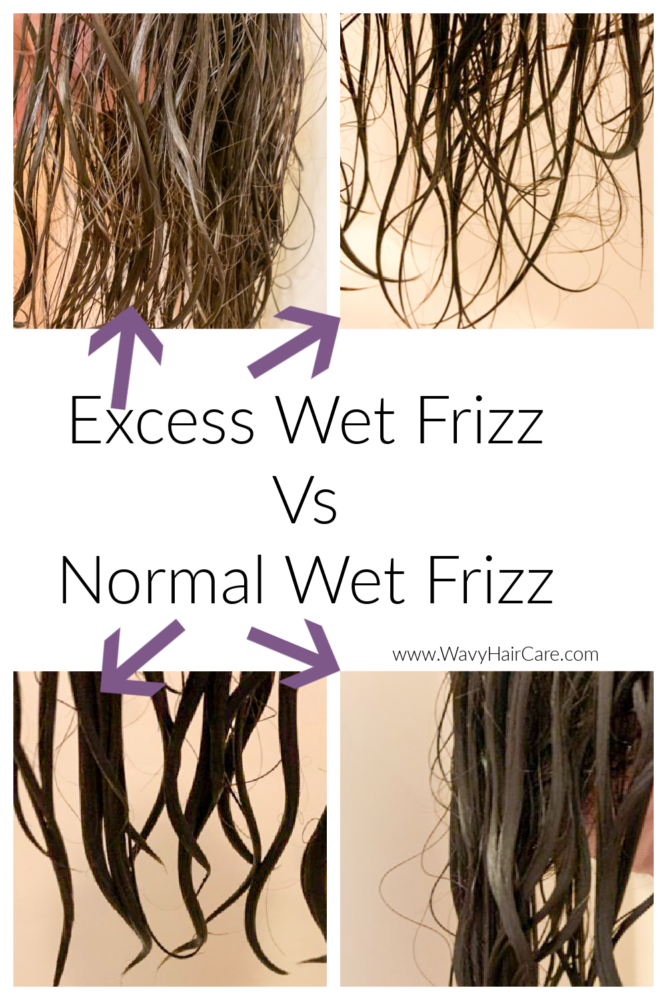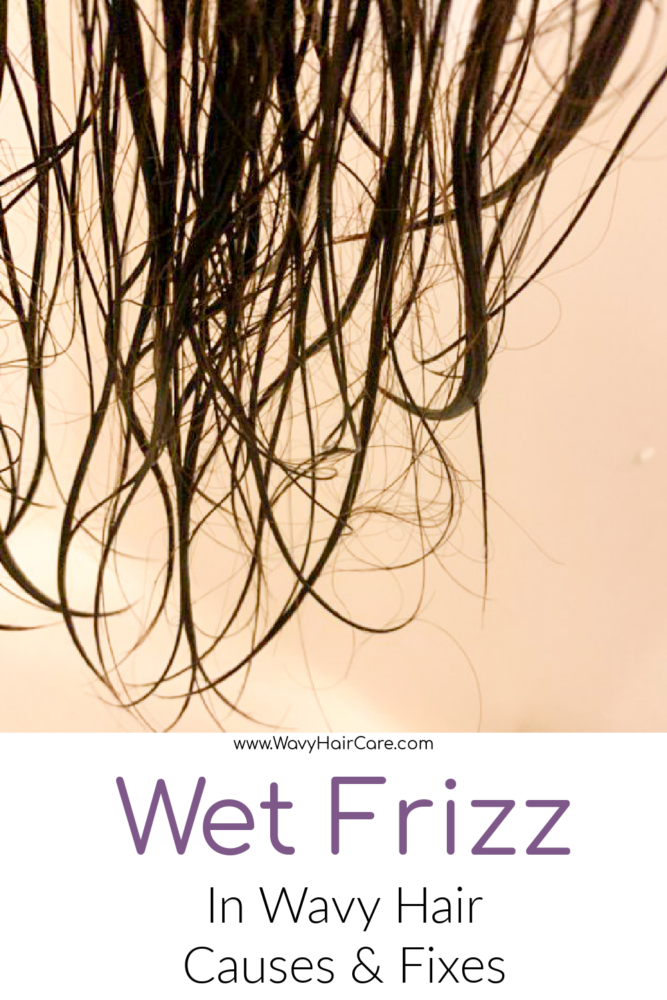What Is Wet Frizz?
Wet frizz is when hair is frizzy while still wet. Rather than forming “clean” curl clumps, the curl clumps will have strings of hair sticking out. A small amount of wet frizz is normal, but having a lot of we frizz can be a sign that your har isn’t getting what it needs.
If your hair is really frizzy while wet, it will likely dry very frizzy, too. If you struggle with frizz and that frizz is present even when your hair is soaking wet, your core issue may be wet frizz rather than regular frizz.
What Causes Wet Frizz?
Wet frizz can be caused by a lack of moisture or conditioning, product build-up, having high porosity hair, flash drying or moisture overload.
If your hair is frizzy while it’s wet, it’s usually lacking moisture and needs to be better conditioned.
In some cases, wet frizz may be caused by build-up. If your hair has significant build-up, it may disrupt your hair from clumping “nicely” in its normal way.
High porosity hair is more likely to experience wet frizz due to the raised cuticles making nearby hairs tangle rather than align together. If you’re new to the concept of hair porosity, I’d recommend checking out my blog post how to determine your wavy hair type.
For some people, moisture overload can include wet frizz. If your hair feels really soft (almost mushy?) and has lost its ‘strength’, gotten very poofy/fluffy or lost its regular definition, and your curls are looser than usual, these are signs of moisture overload and you may benefit from doing a protein treatment.
Flash drying causes wet frizz for some. Some people have hair that responds poorly to certain ingredients. If you find that your hair is soaking wet, and you apply a product and your hair instantly frizzes up while feeling like it got drier – that’s flash drying. In this case, you’ll need to learn what ingredient your hair has flash drying from and avoid that ingredient in your hair care products.
How To Correct Wet Frizz
If you’re experiencing wet frizz and haven’t clarified recently or suspect build-up, you can start by using a clarifying shampoo to see if that helps. I have a whole blog post about clarifying wavy hair if you want to learn more.
If you clarify at least monthly and your hair doesn’t feel like it has build-up, you likely just have dry hair. In this case, the main solution will be to use a deep conditioner. I’d recommend doing one with little or no protein if you suspect your hair is just really dry. Using “squish to condish” each wash day when you have conditioner in your hair can help your hair get more hydrated over time.
If your hair is dry, you may also benefit from adding in a leave-in conditioner to your routine.
Oils may help if used correctly. Oils help seal moisture into the hair, but they do not help moisturize hair on their own. Meaning, washing your hair and then applying just an oil won’t help, but using a leave-in conditioner or cream and then an oil on top may help to lock in the moisture from the conditioner or cream.
If your hair isn’t especially dry, but you regularly experience wet frizz as a result of having high porosity hair, using bond repair products like Olaplex #3 or Curlsmith bond rehab salve may help. Keeping a close eye on your protein-moisture balance is also key.
If your wet frizz is caused by flash drying, you’ll need to experiment until you can pinpoint what ingredients cause flash drying for you, and then avoid products with those ingredients.
How Much Wet Frizz Is Normal Or “Okay”?
How much wet frizz is normal or okay is going to vary somewhat depending on your hair type. Higher porosity hair is likely to have more we frizz than lower porosity hair. Your haircut may make a difference as well. How easily (or not) your hair clumps while wet can depend somewhat on your haircut.
I’d recommend watching your own wet frizz level so that you learn what your normal is, and so that you can recognize if it increases.

However, to give you a rough idea, I made the graphic above to show you what my hair looked like recently when I was experiencing higher-than-normal amounts of wet frizz. I took the top two photos after shampooing and conditioning with my regular products. I realized my hair had excessive wet frizz. I had also started to get some tangles while my hair was wet, which is not typical for me at all.
I knew that my hair was needing moisture. I didn’t want to try to style my hair when it was staying so frizzy, so I decided to use a deep conditioner. I used Not Your Mother’s Curl Talk Masque (it is protein-free) and let it sit in my hair about 10 minutes then rinsed it out. My hair felt less tangly, got better curl clumps and less wet frizz. The lower two photos on the graphic are my hair after the deep conditioner.
I have low to normal/average porosity hair so my amount of wet frizz is less than other hair types are likely to experience. I had a curly cut last summer, but I haven’t had my hair cut or trimmed in over 9 months so my hair cut is definitely grown out a lot and not clumping as well as it used to.

All very good points! I also love Swavy Curly Courtney’s videos on curl clumps which also help with wet frizz. What I didn’t realize was not only that I needed to condition my hair more, but that I needed to use more water while I was in the shower. Now when I condition my hair I make sure it has the right amounts of water to partner better with the conditioner and help lock in moisture.
My hair is low porosity and needs light products, and for a leave in conditioner, I really like NYM Royal Honey and Kalahari Desert Melon leave in conditioner. It’s light but very effective still and I don’t think it has protein in it.
Ohh that kinda makes me want to try that leave-in. I’ve been happy with a lot of other NYM products, including the royal honey shampoo and conditioner but haven’t tried the leave in. My hair has continued to need more moisture than it had needed for a long time so I think I’ll be trying leave-in conditioners in the near future even though I usually don’t use any.
How can you tell if it is protein or moisture needed? My wet frizz, and subsequently dry frizz, are bad. I wash with NYM green shampoo and conditioner, Kinky Curly leave in (which may be the problem), NYM mousse, Ms Jessie Pillow curls, then plop for a few minutes, and diffuse with my shark blow dryer. I know my hair is damaged and was dry. I wonder if I over moisturized in my zeal to get my curls back.
I personally find moisture-protein balance to be one of the harder things to figure out. When I first started reading signs of moisture and protein balance, I almost felt like people were speaking a different language, haha. I had never felt like my hair was ‘gummy’ or ‘mushy’ for example. I used to feel like my hair always felt the same pretty much? But as I got more into hair care, I started paying really close attention to how my hair physically felt and how it “behaved” and eventually I was able to start noticing the subtle differences. My hair gets over moisturized really easily, so I have a lot more experience with noticing when my hair needs protein vs when it needs moisture as it rarely needs more moisture. Here is a post of mine sharing the signs that my hair needs protein:
https://wavyhaircare.com/how-i-know-when-my-wavy-hair-needs-protein/
Based on the products you shared using, I doubt you’d be at risk of protein overload as the only product in that list that contains protein is the ms jessies. So *if* you’re off balance, it’s probably a lack of protein. However, having a lot of frizz doesn’t necessarily indicate that your balance is off. If you have a lot of damage, that can cause frizz even if your moisture-protein balance is spot on. Frizz can be caused by product build up or hard water related build up (so using a clarifying or chelating shampoo would help if those were the culprits) or it can just be damaged hair. Often when someone has really frizzy looking hair, it’s actually a bunch of short, broken hairs or “flyaways”. If that’s the case, then slicking the little hairs down with gel until they grow out and can stay down more naturally is usually the best temporary solution. Longterm, you’d want to try to avoid getting new breakage by treating your hair more gently.
Also, you might ask a friend who you know will be really honest with you if they feel you have a lot of frizz. Sometimes in wavy hair groups people share selfies worried about having tons of frizz and it’s really not a lot of frizz at all! It’s natural to notice your own frizz more than you notice other people’s, so that can result in us feeling like our frizz is bad even if it’s not, sometimes.